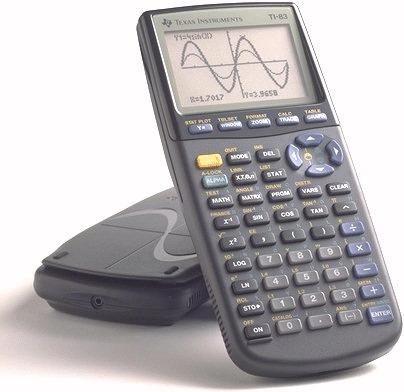Comment #1
Comment #2
Comment #3
Interface:
That's right, it's the TI-83 Plus that we all use to know and love--most of us anyway. I can still remember the hordes of people who constantly whined about not knowing how to operate it. I can't really blame them though, because it's a pretty complex calculator. There are still things that I know the calculator can do, but I have no idea how to actually do them. The things I did manage to figure out were learned by... reading the manual (let's see you try to find the intersection between two trig functions after just picking it up).
This is a pretty good example of poor mapping. First of all, there is a yellow and green button which are like a "shift" function. Almost every key serves three functions. For example, the x^2 button can be used to square a number, find the square-root of a number (using the yellow button), or to type the letter "I" (using the green button). That is almost acceptable, because everything is at least color-coded and printed by the keys on the calculator.
What if you want to find the factorial of a number? It sounds simple enough, but it's a function that isn't listed on the keys of the calculator. To perform the factorial operation you first have to type in the number. Then you press the "MATH" button. Determining the factorial of a number is a math operation, so it seems to make sense so far. Once selected, a screen with four sub-menus pops up. To select the factorial operation, you have to scroll over to the menu labeled "PRB" (I still don't know what that stands for). Then, you see the menu item "!". Now, this is either the factorial operation you were praying to find, or it's something that is used when typing out "i h8 u ti83, lolz!!1"
Imagine picking up this device for the first time and trying to do this. You'd be better off finding the pdf manual for the TI-83 online and trying to look it up. Who would think to look under a sub-menu labeled "PRB" for it?
Another example of something that isn't very straightforward deals with buttons that serve different purposes in different modes. When accessed from the main screen, the "PRGM" button is used to select programs to run on your calculator; however, it's used for something else when you're writing your own programs. In this case, the button is used to access a list of all the available built-in functions that can inserted into your program (prompt, pause, goto, etc).
Way..wayyyy back in the day, I had tried to type in (letter for letter) an example program from somewhere and couldn't figure out why it wasn't working. After reading the manual, I learned that instead of typing "p-r-o-m-p-t" (which doesn't do anything), you have to select it from the menu using the "PRGM" button... duh.
I thought I was just dumb. As it turns out, I was just another victim of bad design. That's what I tell myself anyway. It was unnatural mappings, feature creep, and other poor design-choices that made this calculator the bane many student's existence.


